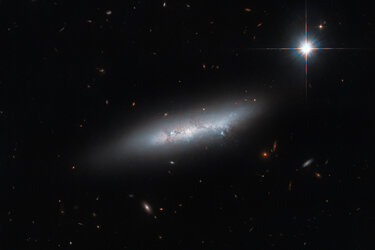Accept all cookies Accept only essential cookies See our Cookie Notice

About ESA
The European Space Agency (ESA) is Europe’s gateway to space. Its mission is to shape the development of Europe’s space capability and ensure that investment in space continues to deliver benefits to the citizens of Europe and the world.
Highlights
ESA - United space in Europe
This is ESA ESA facts Member States & Cooperating States Funding Director General Top management For Member State Delegations European vision European Space Policy ESA & EU Space Councils Responsibility & Sustainability Annual Report Calendar of meetings Corporate newsEstablishments & sites
ESA Headquarters ESA ESTEC ESA ESOC ESA ESRIN ESA EAC ESA ESAC Europe's Spaceport ESA ESEC ESA ECSAT Brussels Office Washington OfficeWorking with ESA
Business with ESA ESA Commercialisation Gateway Law at ESA Careers Cyber resilience at ESA IT at ESA Newsroom Partnerships Merchandising Licence Education Open Space Innovation Platform Integrity and Reporting Administrative Tribunal Health and SafetyMore about ESA
History ESA Historical Archives Exhibitions Publications Art & Culture ESA Merchandise Kids Diversity ESA Brand Centre ESA ChampionsLatest
Space in Member States
Find out more about space activities in our 23 Member States, and understand how ESA works together with their national agencies, institutions and organisations.
Science & Exploration
Exploring our Solar System and unlocking the secrets of the Universe
Go to topicAstronauts
Missions
Juice Euclid Webb Solar Orbiter BepiColombo Gaia ExoMars Cheops Exoplanet missions More missionsActivities
International Space Station Orion service module Gateway Concordia Caves & Pangaea BenefitsLatest
Space Safety
Protecting life and infrastructure on Earth and in orbit
Go to topicAsteroids
Asteroids and Planetary Defence Asteroid danger explained Flyeye telescope: asteroid detection Hera mission: asteroid deflection Near-Earth Object Coordination CentreSpace junk
About space debris Space debris by the numbers Space Environment Report In space refuelling, refurbishing and removingSafety from space
Clean Space ecodesign Zero Debris Technologies Space for Earth Supporting Sustainable DevelopmentLatest
Applications
Using space to benefit citizens and meet future challenges on Earth
Go to topicObserving the Earth
Observing the Earth Future EO Copernicus Meteorology Space for our climate Satellite missionsCommercialisation
ESA Commercialisation Gateway Open Space Innovation Platform Business Incubation ESA Space SolutionsLatest
Enabling & Support
Making space accessible and developing the technologies for the future
Go to topicBuilding missions
Space Engineering and Technology Test centre Laboratories Concurrent Design Facility Preparing for the future Shaping the Future Discovery and Preparation Advanced Concepts TeamSpace transportation
Space Transportation Ariane Vega Space Rider Future space transportation Boost! Europe's Spaceport Launches from Europe's Spaceport from 2012Latest

An island universe
Thank you for liking
You have already liked this page, you can only like it once!
In this week’s Hubble Picture of the Week we are treated to a wonderfully detailed snapshot of NGC 3430. A spiral galaxy, it lies 100 million light-years from Earth in the constellation Leo Minor. Several other galaxies are located relatively nearby to this one, just out of frame; one is close enough that gravitational interaction is driving some star formation in NGC 3430.
That NGC 3430 is such a fine example of a galactic spiral may be why it ended up as part of the sample that Edwin Hubble used to define his classification of galaxies. Namesake of the Hubble Space Telescope, in 1926 he authored a paper which classified some four hundred galaxies by their appearance — as either spiral, barred spiral, lenticular, elliptical or irregular. This straightforward typology proved immensely influential, and the modern, more detailed schemes that astronomers use today are still based on it. NGC 3430 itself is an SAc galaxy, a spiral lacking a central bar with open, clearly-defined arms.
At the time of Hubble’s paper, the study of galaxies in their own right was in its infancy. With the benefit of Henrietta Leavitt’s work on Cepheid variable stars, Hubble had only a couple of years before settled the debate about whether these ‘nebulae’, as they were called then, were situated within our galaxy or were distant and independent. He himself referred to ‘extragalactic nebulae’ in his paper, indicating that they lay beyond the Milky Way galaxy. Once it became clear that these distant objects were very different from actual nebulae, the favoured term for a while was the quite poetic ‘island universe’. While NGC 3430 may look as if it still deserves this moniker, today we simply call it and the objects like it a ‘galaxy’.
[Image Description: A spiral galaxy with three prominent arms wrapping around it, and plenty of extra gas and dark dust between the arms. There are shining blue points throughout the arms and some patches of gas out beyond the galaxy’s edge, where stars are forming. The centre of the galaxy also shines brightly. It is on a dark background where some small orange dots mark distant galaxies.]
-
CREDIT
ESA/Hubble & NASA, C. Kilpatrick -
LICENCE
CC BY 4.0 INT or ESA Standard Licence
(content can be used under either licence)

Galaxies in miniature

“Late-type” galaxy?

A spiral and a star

Hubble spies a meandering spiral















 Germany
Germany
 Austria
Austria
 Belgium
Belgium
 Denmark
Denmark
 Spain
Spain
 Estonia
Estonia
 Finland
Finland
 France
France
 Greece
Greece
 Hungary
Hungary
 Ireland
Ireland
 Italy
Italy
 Luxembourg
Luxembourg
 Norway
Norway
 The Netherlands
The Netherlands
 Poland
Poland
 Portugal
Portugal
 Czechia
Czechia
 Romania
Romania
 United Kingdom
United Kingdom
 Slovenia
Slovenia
 Sweden
Sweden
 Switzerland
Switzerland
























